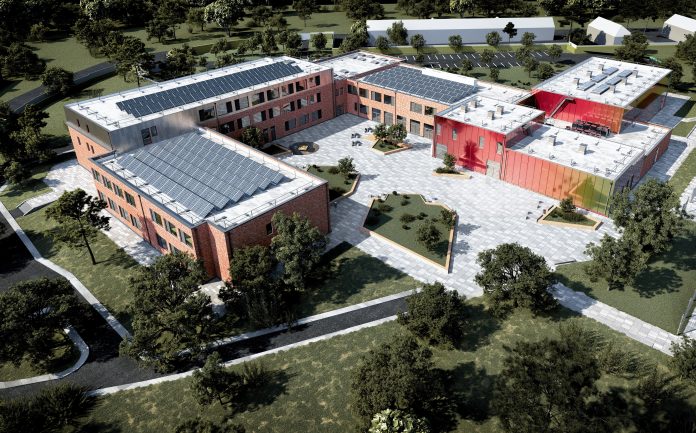Modern Methods of Construction are disrupting the industry, creating a new set of design expectations and pushing boundaries with the use of new technologies and systems. As the construction industry continues to face increased pressures amidst a global skills shortage, Martin Harvey, head of design and technical services at McAvoy, discusses how offsite can assist with streamlining the industry
There is no doubt construction has recognised and embraced the benefits of the volumetric offsite industry. The offsite sector has improved dramatically in recent years, creating a totally immersive process that streamlines construction efficiencies with clever design possibilities.
Innovations in technology have pushed the envelope of design capabilities and presented manufacturers with fresh opportunities to create and implement new and innovative ideas to significantly improve speed, quality and accuracy of the volumetric offsite product.
The construction industry as a whole is facing unprecedented pressures. The combination of Brexit and the pandemic has led to a well-publicised shortage of both people and skills.
With an increased demand for schools, hospitals and houses – coupled with the government’s ambitious CO2 emission targets – the industry is standing at a crossroads with firms being forced to rethink how they deliver.
The argument for offsite manufacturing providing the solution to this crisis is now stronger than ever, with its reduced reliance on a diminished trade-based skills pool, its versatility and its undeniable eco credentials.
Innovative solutions to the skills crisis
At McAvoy, we have created innovative ways to tackle the skills crisis by adapting our own training programmes to produce multiskilled employees capable of carrying out a range of manufacturing and construction activities within our offsite environment.
We work in partnership with a range of private sector and industry bodies, regional and local colleges to create and deliver robust training and development programmes including HLAs and apprenticeships that extend beyond our mandatory requirements – right across the company from design to manufacturing, health and safety and site management.
Digitally led innovation has revolutionised the industry
New technological capabilities have revolutionised the process of design, manufacturing and construction.
Having recently adopted ISO 19650 Part 2, BIM is central to all McAvoy’s design and manufacturing processes. All our in-house designs are completed using BIM and all discipline models are federated to reduce and eliminate risky (and often expensive) inaccuracies when manufacturing in the factory or constructing on-site.
At McAvoy, we have been able to streamline the whole design process by developing a data-rich, DfMA model, which is created early in the design process, enabling us to produce a detailed model of our steel frame once the floorplan has been agreed. Above the standard outputs of model federation, VR, Cobie data and clash detection, the new model can automate accurate steel part lists and improve cost certainty much earlier than previous projects.
This, however, can only be achieved through a standardised approach. McAvoy has developed standardised platforms for each market sector, which improve the efficiencies of our processes without compromising on the bespoke requirements of our clients.
A great example of this would be the Seismic project in which McAvoy was a core partner in developing the new componentised, platform-based approach to construction, which can be adopted by multiple manufacturers. The Seismic demonstrator building, which was delivered on site in 23 days, is the culmination of a four-year project developed by a consortium comprising consultancy blacc, offsite manufacturers McAvoy & Algeco UK (formerly Elliott), as well as Tata Steel, the Manufacturing Technology Centre (MTC), the National Composite Centre (NCC) and Specific (part of Swansea University).
Designed to work towards the government’s Construction 2025 targets, the building was delivered 33% quicker and with a 32% lower carbon impact than that of the standard volumetric offsite product.
At the centre of the platform is a standardised frame and connector, which allows a number of repeatable components to be held in stock and built offline. This frees up time to focus on areas that add the most value to the design and create a quality sense of place for the end users.
There are also wider benefits for the industry
For example, by moving more of the construction process into a factory environment, we can improve health and safety as work takes place in a very controlled and safe environment where working at height and manual handling are significantly reduced.
McAvoy are also currently involved in a similar innovation project for which we are further pushing the boundaries of offsite construction to complete a greater volume of work in the factory and offer a wider range of finishes to the floors, walls and fit-out. The project marries the latest technologies in 2D panelised and 3D volumetric methods of construction to complete spaces of varying sizes, heights and fit-out.
Projects like these highlight the new possibilities that offsite presents. Contrary to popular belief, modular buildings are now increasingly flexible, with varying design options and combinations available.
Now more than ever, offsite manufactured buildings enable clients to benefit from a total design solution that meets all regulations, is compliant with government standards, offers clients wide-ranging flexibility and offers a seamless experience.
The industry is facing increased pressure to be more sustainable
Offsite construction is crucial in enabling the success of the government’s Construction 2025 strategy as it can significantly reduce delivery programmes, minimise environmental impact and deliver impressive air tightness and thermal performance.
For many years, McAvoy has been employing circular construction techniques, with core components capable of being reused and recycled. Modules, for example, are designed to have the ability to be stripped back to the shell and repurposed as part of a different building, thereby saving money, time and CO2 emissions.
With digital technology ever-evolving, volumetric offsite manufacturing will continue to be better, smarter and more efficient, transforming the way we design and create, and it will remain an integral part in the evolution of construction industry.
Martin Harvey
Head of design and technical services
McAvoy
Tel: +44 (0) 28 8774 0372














